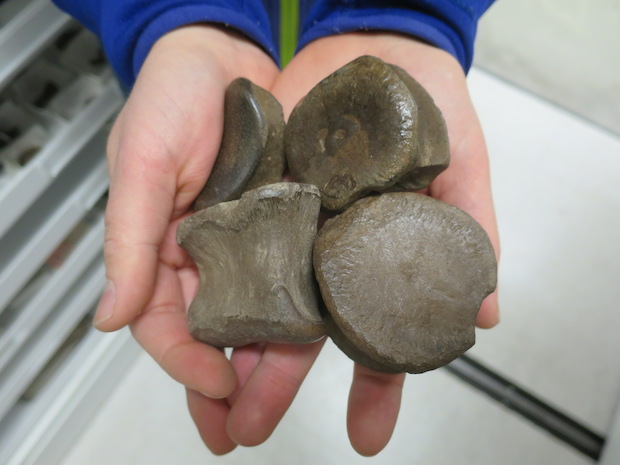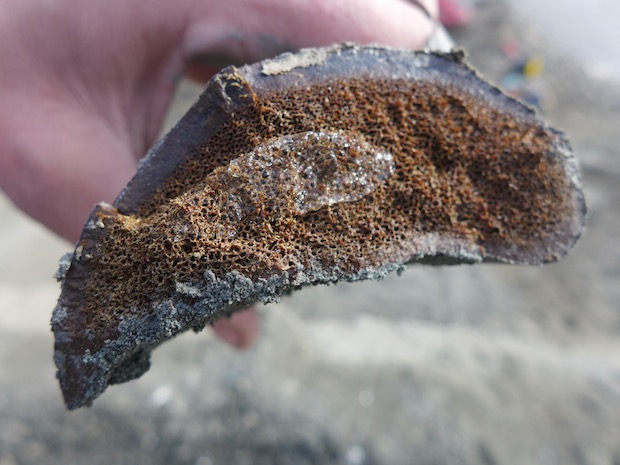New dinosaur species may have left tracks in the snow
Spend enough time watching Jurassic Park movies and you start believing all dinosaurs lived out their lives in the tropics, rumbling across rolling plains or grazing in forests.
But a study published on Tuesday found that a new species of duck-billed dinosaur liked it cold and may have trudged through snow.
Examining a site teeming with bones at the Colville River in northern Alaska known as the Prince Creek Formation, researchers from Florida State University and University of Alaska Fairbanks believe this 30-foot-long grazer is the northernmost dinosaur ever found.
"The finding of dinosaurs this far north challenges everything we thought about a dinosaur's physiology," Greg Erickson, a Florida State biological science professor who was part of the team that discovered the new dinosaur, said. "It creates this natural question, how did they survive up here?"
The dinosaur, named Ugrunaaluk kuukpikensis, meaning ancient grazer of the Colville River, is detailed in the paleontology journal Acta Palaeontologica Polonica. Ugrunaaluk kuukpikensis is most closely related to Edmontosaurus, another type of duck-billed dinosaur that lived roughly 70 million years ago in Alberta, Montana and South Dakota.
But the combination of features found in these skeletons was not present in Edmontosaurus or in any other species of duck-billed dinosaurs.
"This new study names and brings to life what is now the most completely known species of dinosaur from the Polar Regions," said Patrick Druckenmiller, Earth sciences curator of the University of Alaska Museum of the North and associate professor of geology at the University of Alaska Fairbanks.
Ugrunaaluk kuukpikensis adds to a growing body of evidence that showed there were dinosaurs that thrived in colder regions as long as 100 million years ago.
In recent decades, paleontologists digging at a site in Australia known as Dinosaur Cove, at the country's southeastern tip, found dinosaurs that were well adapted to colder conditions, according to the U.S. Geological Survey. Known as polar dinosaurs, they apparently had good night vision and were warm-blooded, enabling them to forage for food during long winter nights in a region that was well within the Antarctic Circle, the USGS said.
Further evidence came in 1991 when paleontologists discovered Cryolophosaurus ellioti, a previously unknown dinosaur species and the only one found on the continent of Antarctica, the USGS said. Cryolophosaurus fossils were found at Mount Kirkpatrick, located only about 370 miles from the South Pole.
The site of the latest discovery - the Prince Creek Formation - has fascinated scientists for decades.
An arctic, coastal flood plain about 69 million years old, it is teeming with skeletons of what researchers believe are at least 13 different species of dinosaur, based on teeth and other remains, and which are different than those found at lower latitudes. There are also birds, small mammals and some fish.
These dinosaurs were believed to have thrived well above what is known as the paleo-Arctic Circle, about 80 degrees north latitude. It may have been cold but not as cold as what visitors might see today. They likely lived in a world where the average temperature was about 43 degrees Fahrenheit, and they probably saw snow. But because temperatures were more temperate than today, the area also was covered with trees.
"What we're finding is basically this lost world of dinosaurs with many new forms completely new to science," Erickson said of the site, where scientists have collected more than 9,000 bones and reaching it means using bush planes that are capable of landing on gravel bars, inflatable boats and rappelling down the side of a cliff to do the digging.
"Alaska is basically the last frontier," he continued. "It's virtually unexplored in terms of vertebrate paleontology. So, we think we're going to find a lot of new species."
The majority of the bones of the Ugrunaaluk kuukpikensis were collected from a single layer of rock called the Liscomb Bonebed. The layer, about 2 to 3 feet thick, contains thousands of bones of primarily this one species of dinosaur. In this particular area, most of the skeletons were from younger or juvenile dinosaurs, about 9 feet long and 3 feet tall at the hip.
"Because many of the bones from our Alaskan species were from younger individuals, a challenge of this study was figuring out if the differences with other hadrosaurs was just because they were young, or if they were really a different species," Druckenmiller said. "Fortunately, we also had bones from older animals that helped us realize Ugrunaaluk was a totally new animal."
Researchers believe this herd of juveniles must have been killed by a sudden event.
"The bone bed layer is obviously a herd of animals that died suddenly but we don't have any direct evidence of what killed them," Druckenmiller told CBS News. "We think one possibility based on what we can see from the rocks and all these animals being together is that perhaps a herd of young animals was trying to cross a river during the spring and were swept to their deaths."


